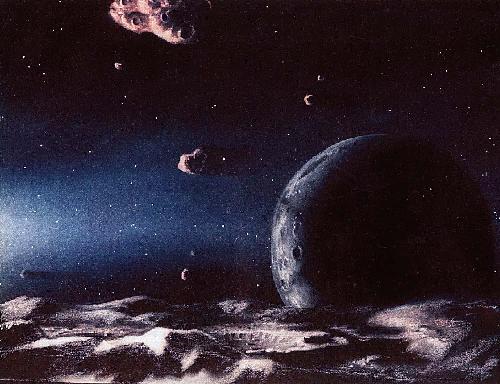
| CLASSICAL KUIPER BELT OBJECTS (CKBOs) |
|---|
A majority of the observed Kuiper Belt Objects maintain large separations from Neptune even when at perihelion. The archetypal "Classical KBO" is 1992 QB1. Such objects are able to survive for the age of the solar system without the special protection offered by resonances to the Plutinos, simply because they are already Neptune-avoiding.
The Outer Edge
The CKBOs are found mostly with semi-major axes between about 42 and 47 AU. The deficiency of more distant CKBOs is real: the Classical Belt has an outer edge near the 2:1 resonance at 47 AU. The CKBOs are "classical" in the sense that their orbits tend to have small eccentricities as is expected of bodies formed by quiet agglomeration in a dynamically cool disk. There is still evidence for excitation, though, as discussed below, and there is no suggestion that even the CKBOs are remnants of the undisturbed accretion disk (as some of us initially hoped).
Inclinations
The inclinations (see also PDF version) of the Classical KBOs range up to very high values (1996 RQ20 and 1997 RX9 have i > 30 degrees). This suggests that the inclinations have been excited by some agency yet to be identified.
Excitation
Several ideas have been suggested for the excitation mechanism:
i) A few massive planetesimals might have been scattered into the Kuiper Belt in the early days by Neptune. These objects could excite the inclinations of the CKBOs. One problem with this hypothesis is that massive planetesimals (they would have to approach Earth mass in order to be effective) would also disturb and depopulate the resonances. That we see many Plutinos is evidence against the action of massive planetesimals. Also, no suitably massive (Mars mass) scatters remain in the belt.
ii) A passing star might have stirred up the CKBOs. Proponents of this idea claim, based on numerical simulations, that the Classical objects can be excited while the Plutinos remain relatively undisturbed. One obvious problem with the external perturbation hypothesis is that passing stars rarely pass close enough to the sun (a miss distance of a few 100 AU is required). However, it is possible (likely?) that the sun formed with other stars in a cluster that might have been initially very dense. In this case, the early rate of close stellar passages might have been much higher than at present.
The outer edge of the Classical Kuiper Belt, near 50 AU, could also be a result of disturbance by a close encounter with a passing star. This scenario has been explored by Ida et al. (2000) (PostScript - about 0.8 Mbyte)
It is worth noting that stellar close approaches and resulting tidal truncation have been suggested as the cause of the sharp edged and small disk-like structures known as Proplyds. Some proplyds are only 50 AU to 100 AU across, similar to the diameter of the known portion of the Classical Kuiper Belt.
iii) The same disturbing function could be supplied by a distant, unseen planet. The planet might have been subsequently ejected (but how?) or could await detection. Here are some notes about this hypothesis, by the person who most recently proposed it.
iv) The excited inclinations could result from an early disturbance in the solar system, associated with the migration of the planets. In this model, the inclinations can be reproduced, but no explanation of the outer edge to the classical KBO distribution is provided.
 |
Kuiper Belt |
|---|
Last Update August 2009